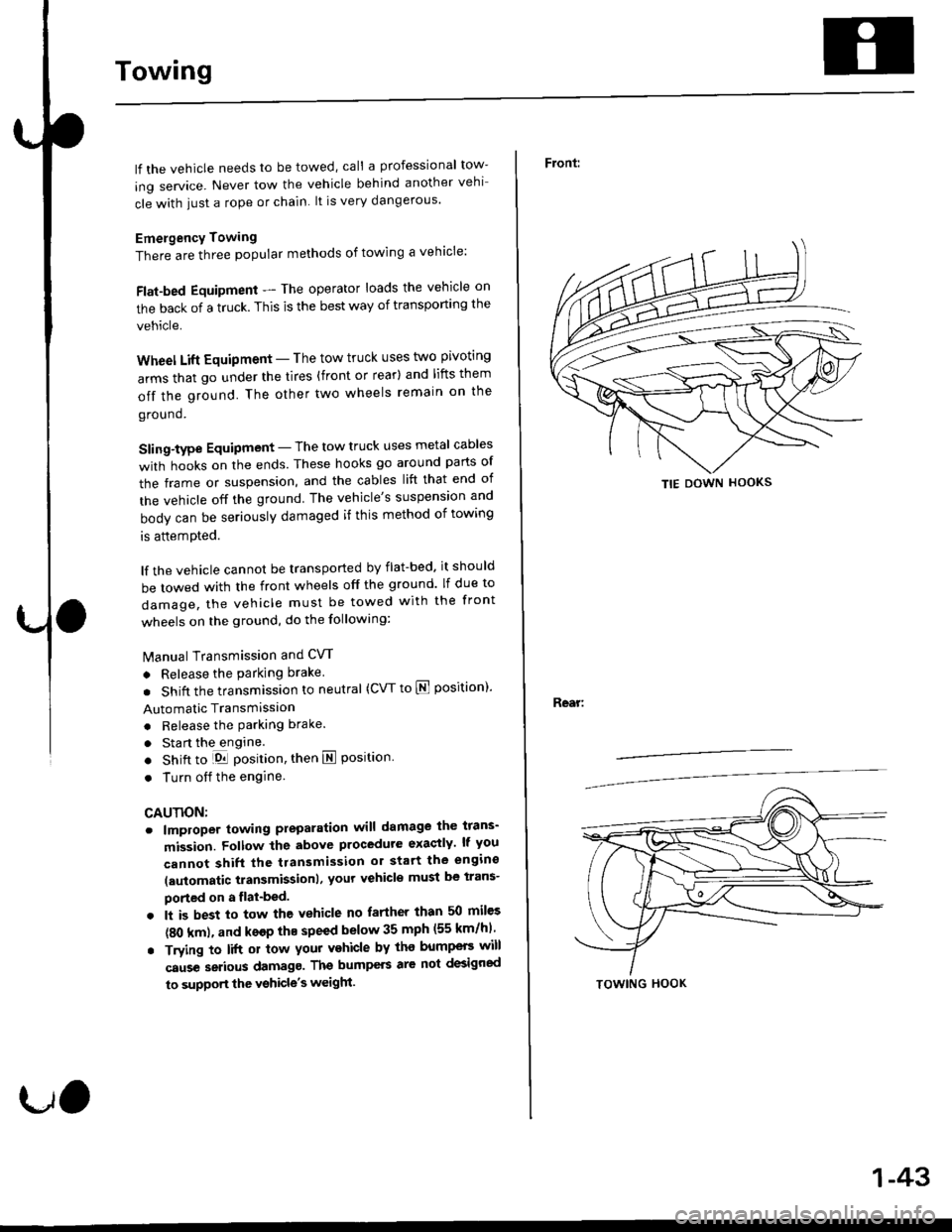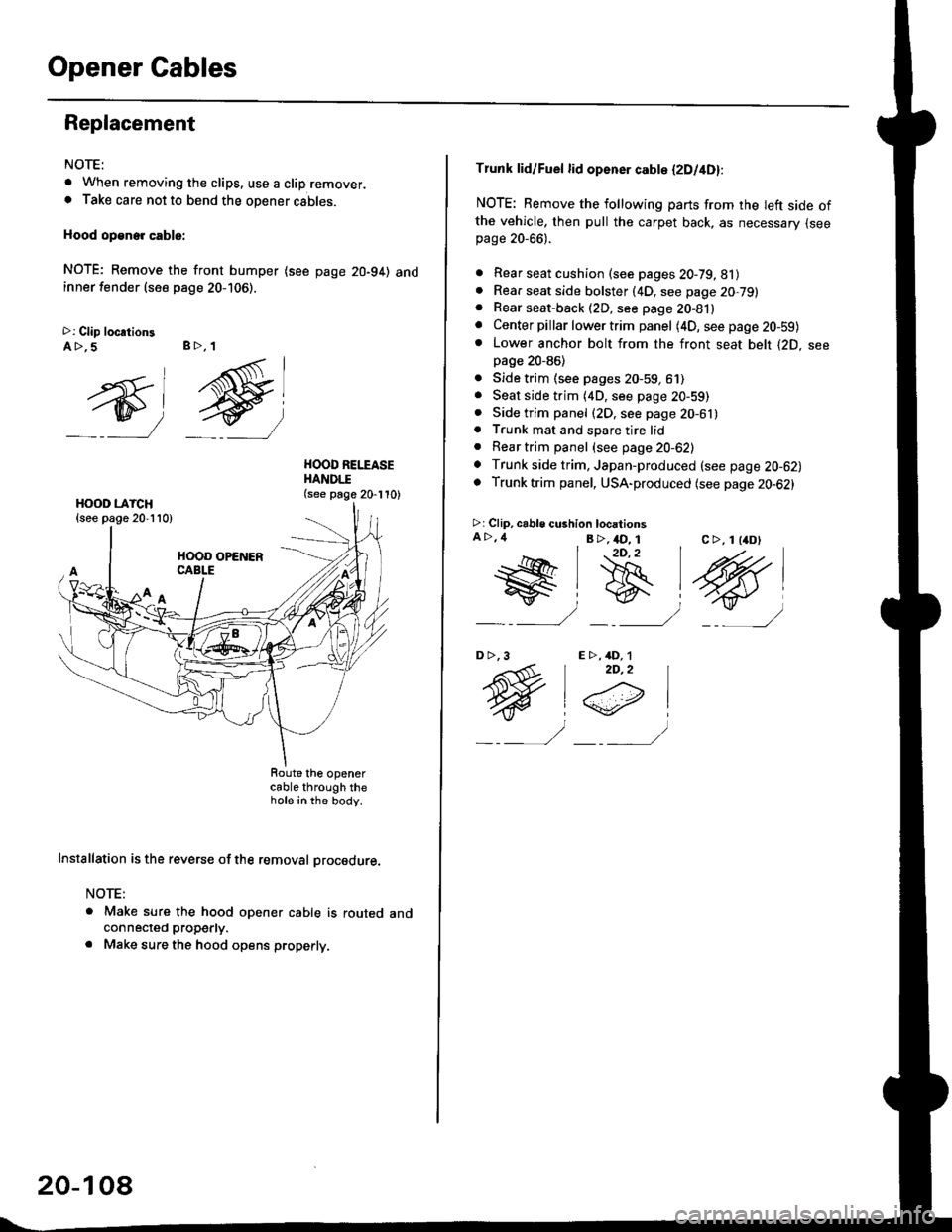Page 44 of 2189
Lift and Support Points
Floor Jack
Apply the parking brake and block the wheets thatare not being lifted.
When lifting the rear of the vehicle, put the gearshiftlever in reverse (Automatic transmission/Cw in Eposition).
Raise the vehicle high enough to insert the safetystands.
Adjust and place the safety stands so the vehiclewill be approxlmately level, then lower the vehicleonto them.
FRONT:
Always use safety stands whon working on or undelany vehicle that is supported by only a iack.Never attempt to use a bumper jack for lifting orsupporting the vehicle.
t,1.
REAR:
1-42
LIFT PLA
4.
Center the jacking
bracket in the middleof the iack lift platform.
Center the iackbracket in the middleof the jack lift ptatform.
-,-_
LIFT PLATFORM
L,
Page 45 of 2189

Towing
lf the vehicle needs to be towed, call a professional tow-
ing service. Never tow the vehicle behind another vehi
cle with iust a rope or chain lt is very dangerous'
Emergency Towing
There are three popular methods of towing a vehicle:
Flat-bed Equipment - The operator loads the vehicle on
the back of a truck. This is the best way of transporting the
vehicle.
Wheel Lift Equipment - The tow truck uses t\ivo pivoting
arms that go under the tires {front or rear} and lifts them
off the ground. The other two wheels remain on the
ground.
Sling-type Equipment - The tow truck uses metal cables
with hooks on the ends. These hooks go around parts of
the frame or suspension, and the cables lift that end of
the vehicle off the ground The vehicle's suspension and
body can be seriously damaged if this method of towing
is attemDted.
lf the vehicle cannot be transported by flat-bed. it should
be towed with the front wheels off the ground lf due to
damage, the vehicle must be towed with the front
wheels on the ground, do the following:
lvlanual Transmission and CW
. Release the parking brake
. Shift the transmission to neutral (CW to E position)'
Automatic Transmission
. Release the Parking brake.
. Sta rt the engine.
. Shift to LDll position, then E position.
. Turn oif the engine
CAUTION;
o lmploper towing preparation will damage ihe tfans-
mission. Follow the above procedute exaqtly lf you
cannot shift the tlansmission or start the engino
laulomatic transmissionl, yout vehicle must be trans-
ported on a flat-bed.
. lt is best to tow the vehicle no farther than 50 mil€s
(80 km), and ksop thE speed below 35 mph (55 km/hl
. Trying to lift 01 tow your vehicle by tho bump€F will
caus€ setious damagg. Ths bumpers are not dEigned
to supportthe vshicle's weigh.
tJO
1-43
Front:
Rear:
TIE DOWN HOOKS
TOWING HOOK
Page 1323 of 2189
Exterior
Component Location Index
NOTE: Refer to the Civic BodV Repair Manual, '1996 Model Series, P/N.6150330,forthe hood, trunk lid and hatch removal.
2Dl30llDl
LICENSE PLATETRIM TRUNK LIDROOF MOLOINGReplacement,
SIDE WINDOWMOLDINGSReplacement,page 20-102Replacement,page 20-100Adjustment, page 20-97Tolsion Bar Removal,page 20-10220 99
HOODAdiustment, page 20 96Hood Edge protector
Replacement, page 20 99
TRUNK LIDWEATHERSTRIPReplacement,page 20-100
REAR BUMPERReplacement,page 2O-95
SILL PANELReplacement, page 20 105
REAR AIR OUTLETReplacement,page 20-106
FUEL PIPEPROTEfiORReplacement,page 20-106
FENDERWELL TRIMReplacement, page 20-106
Replacement,page 20-106
3D:
HATCH
HATCHAdjustment,page 20-98
WEATHERSTRIP
20-93
Page 1324 of 2189
Front Bumper
Replacement
CAUTION: Put on glov$ to protect your hands.
NOTE:
. An assistant is helpful when removing the front bumper.
. Take care not to scratch the front bumDer and bodv.
FRONT BUMPERSIDE SNFFENER
lnstallation is the reverse of the removal orocedure.
NOTE:
. Make sure the front bumper engages the front
bumper side stiffener on each side securely.
. lf necessary, adjust the front bumper side stiffener
to obtain the proper gap.
>: golt, screw locationsa>,2B>,2>: Cliplocations, 7
iAerr:ore. A lm
L.'* fl'T;Ll'
o'n' -'
\€5>_ JIc>,4 ,D>,4
| -.6a 8 x 't.25 mm l,Rt o x 1.0 mm
l(Dl[m 22N.n'.t2.2kstnf'. j(Qll@ s.e N.m rr.o rsf.m,t'KJ) 16 tbf.ft, |. -ll 7.2 tbf.hJ
ABSORBER
FRONT EUMPERBEAM
FRONT BUMPERSIDE STIFFENER
FRONT BUMPER BEAM
:l
I ir
\
20-94
Page 1325 of 2189
Rear Bumper
Replacement
CAUTION: Put on gloveslo protect your hands.
NOTE:
. An assistant is helpful when removing the rear bumper.
. Take care not to scratch the rear bumper and body.
. 2D and 4D shown here;3D removal procedures are the same as 4D.
>: Screw, boll locationsA>,2 B>,4>: Clip locations, 7
Installation is the reverse of the removal Drocedure.
NOTE:
. lf necessary, replace any damaged clips.
. Make sure the rear bumper engages the side clip on each side securely.
n ,/_- Ert . -*E]s-
.A IVilIdfIT*ff
*,r/ \7
REAR BUMPER BEAM
REAR BUMPER
20-95
Page 1329 of 2189
Front Grille/Hood Edge
Protector
Trunk Lid Torsion
Bars
Replacement
Front grille:
NOTE: Take care not to scratch the front bumper'
Remove the front bumper (see page 20-94) Bemove the
clips and screws, then slide the front grille forward by
detaching the hooks.
>: Screw locations, 4
"qL
A +lt /
Hood edge Ploteetor:
NOTE:
. When removing the clips, use a cllp remover.
. lf necessary, replace any damaged clips.
>:Clip locations, 18
FRONT BUMPER
HOOD EDGE
/A.- -----,_ ,,, \-'-l
o[_]
20-99
Removal
CAUTION: Pui on gloves to protect your hands.
NOTE: Take care not to damage the body
Remove the torsion bars with the torsion bar assembly
tool while holding the trunk lid as shown.
CENTER CLIP
E
lnstallation is the reverse of the removal procedure'
NOTE:
. Adjust the torsion bars fore or aft with the
sion bar assemblY tool as shown
ll = Normal Posrtlona = Higher tensron
. Make sure the trunk lid opens properly.
tor-
Page 1336 of 2189
Inner Fender, Fenderwell rrim, Fuel Pipe protector and Rear
Air Outlet
Replacement
NOTE: lf necessary, replace any damaged clips.
Inner tender:
>: Screw locations,4
r\
tllpo" l:,/
>: Clip locations, 7
Fenderwell trim/Fuel pipe protector/Rea. air outlet:
NOTE:
. Take care not to bend the fenderwell trim.. Before lnstalling the fenderwell trim, clean the bodybonding surface with a sponge dampened in alcohol.. After cleaning, keep oil, grease or water from getting onthe surface.
. To remove the fuel pipe protector, first remove the rearwheel (see section 18).. To remove the rear air outlet, first remove the rearbumper (see page 20 95).
STEEL FENDERWELL
>: Clip locationsA>,4B>,4
l;1A
!--l1!
c >,2
I
tAh'frv
\:
+
\-
20-106
Page 1338 of 2189

Opener Cables
Replacement
NOTE:
t When removing the clips. use a clip remover.. Take care not to bend the opener cables.
Hood op€ne. cable:
NOTE; Remove the front bumper (see page 20-94) andinner fender (see page 20-106).
>: Clip loc.tionsA >,5 B>, 1
ry)
g
HOOD REI.TASEHANDI.I(see page 20-110)
cable through thehote in th6 body.
Installation is the reverse of the removal procedure.
NOTE:
a Make sure the hood opener cable is routed andconnected properly.
. Make sure the hood opens properly.
20-10a
Tlunk lid/Fuel lid opener cabte (2Dl4D):
NOTE: Remove the following parts from rhe Ieft side ofthe vehicle, then pull the carpet back, as necessary {seepage 20-66).
. Rear seat cushion (see pages 20-79, 81). Rear seat side bolster (4D, see page 20,79). Rear seat-back (2D, see page 20-81). Center pillar lower trim panel (4D, seepage20-59)o Lower anchor bolt from the front seat belt {2D. seepage 20-86)
. Side trim (see pages 20-59, 61). Seat side trim (4D, see page 20-59). Side trim panel (2D, see page 20-61). Trunk mat and spare tire lid. Reartrim panel (see page 20-62). Trunk side trim, Japan-produced (see page 20-62). Trunk trim panel, USA-produced (see page 20-62)
>r Clip, cable cushion locationsA >,4 B >,4D_ 1c >, 1 l4D)2D,2
t@#lB
_ : _/ _-___)
E >,4D, 12D,2
@i
_ _,, -/
D>,3